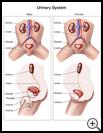
Urinary Blockage
________________________________________________________________________
KEY POINTS
- Urinary blockage is something that slows or stops the flow of urine.
- Your child may need medicine, a tube to help drain urine, or surgery.
- Help your child drink enough liquids to keep the urine light yellow in color. Make changes in your child’s diet recommended by your child’s healthcare provider.
________________________________________________________________________
What is urinary blockage?
Urinary blockage is something that slows or stops the flow of urine. Any part of the urinary tract may become blocked. This includes the:
- Kidneys, which make urine
- Ureters, which are the tubes that carry urine from the kidneys to the bladder
- Bladder, which stores urine
- Urethra, which is the tube that drains urine from the bladder and out of the body
This problem can be from something pressing into the organs from the outside or from the inside of the tubes being blocked. It is also called urinary obstruction.
What is the cause?
There are many possible causes of urinary blockage, such as:
- A problem with how your child’s urinary tract formed before birth
- Birth defects such as spina bifida that affect the spinal cord and nerves
- Growths or tumors of the urinary system
- Kidney stones
- A narrowing of the urethra caused by scar tissue from previous infections or surgeries
- Medicines that can affect bladder emptying, such as cold medicines, allergy medicines, some antidepressants, and narcotics
What are the symptoms?
The symptoms depend on where the blockage is and how much it is stopping the flow of urine. Symptoms may include:
- Crampy pain, sometimes severe, in the belly, side, or back
- In thin children and infants, swelling and fullness of the bladder can be seen or felt
- Irritability
- Cloudy, bloody, or bad-smelling urine
- Trouble urinating
- Loss of bladder control
Your child may not be able to urinate at all, or the flow of urine may be less than usual. The flow may stop and start and your child may not be able to control it. Your child may have dribbling after urinating.
How is it diagnosed?
Your healthcare provider will ask about your child's symptoms and medical history and examine your child. A sample of your child’s urine will be tested. Your child may have the following tests to look at the organs inside the belly and help find where the blockage is:
- X-ray
- An ultrasound, which uses sound waves to show pictures of the organs
- CT scan, which uses X-rays and a computer to show detailed pictures of the organs
- MRI, which uses a strong magnetic field and radio waves to show detailed pictures of the organs
- Voiding cystourethrogram, which uses contrast dye and X-rays to take pictures of the bladder and urethra during urination (voiding)
How is it treated?
The treatment for urinary blockage depends on its cause and how severe it is. The goal is to get urine flowing normally again. This will relieve pain and prevent damage to the kidneys and urinary tract.
If the blockage is between a kidney and the bladder, your child’s healthcare provider may put a drainage tube called a stent in the ureter to drain urine from the kidney. Or your child’s provider may place a tube in the kidney to drain it. Your child may need additional surgery to remove or bypass the cause of the blockage.
If the blockage is between the bladder and the opening of the urethra, your child’s provider may put a catheter into the urethra to drain urine from the bladder. A catheter is a thin, flexible tube. The catheter is usually left in place for a few days or until the cause of the problem can be treated. It also allows the bladder to return to normal size after having been stretched out from holding more than the normal amount of urine because of the blockage.
If the blockage is caused by a stone, your child’s healthcare provider can remove or break up the stone if it does not pass on its own.
If the blockage is caused by a medicine your child is taking, the provider may recommend changing your child’s medicine.
A catheter in the bladder will make it easy for your child to urinate. Then your child’s healthcare provider will remove the catheter as soon as possible.
How can I take care of my child?
Follow the full course of treatment prescribed by your child's healthcare provider. Ask your child’s healthcare provider:
- How and when you will get your child’s test results
- How long it will take your child to recover
- If there are activities your child should avoid and when your child can return to normal activities
- How to take care of your child at home
- What symptoms or problems you should watch for and what to do if your child has them
Make sure you know when your child should come back for a checkup. Keep all appointments for provider visits or tests.
How can I help prevent urinary blockage?
Some causes of urinary blockage cannot be prevented.
It may help if your child:
- Drinks enough liquids to keep the urine light yellow in color.
- Follows any changes in your child’s diet recommended by your provider.
Last modified: 2017-04-12
Last reviewed: 2017-04-10

